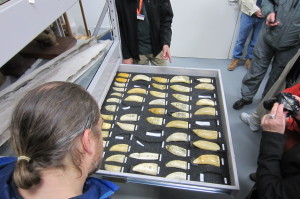One of the great treasures of Mystic Seaport is its research collection. Like any museum, they are only able to display a very small portion of their collection at any given time.
I’ve spent a fair bit of time in the library there, both in its old and its new locations, but it’s always great to visit again. I have also often had a chance to visit the CRC, the building where the library, along with hundreds of small boats, and many other special items that can’t be on display, are stored.
Still, I never pass up a chance to visit the place. Here are a few shots of the hundreds and hundreds of boats in the mill:
From there, we went to the collections storage area – ship models galore, paintings, drawers and drawers of scrimshaw, clothes and costumes, nautical instruments, and so much more.
I can’t quite find ways to describe how important these collections, and the work they do, are. There’s so much more to a museum than just the exhibits, and the Seaport’s library, and its excellent staff, are a perfect example of that. Doing research in a collection like this makes it possible for people to learn new insights, discover old truths, and better understand what our ancestors did and why they acted as they did.
But libraries, especially specialized ones like the Seaport’s, generally don’t get a lot of financial support from their institution. Much smaller libraries (the Seaport’s is the largest maritime library in the US, and one of the largest in the world) have even less support, and are even harder pressed to justify their presence or growth of their part of the organization.
I feel certain that there must be ways to better monetize the resources in the research collection. I realize that could sound heretical, and probably sounds terrible. (I admit, “monetize” isn’t the loveliest word – but it is specific and accurate in this case, so I’ll stick with it.) But it is what needs to be done. A library needs to justify its value to the organization by generating revenue. There’s plenty that can be done for researchers that doesn’t involve revenue generation, but there is so much more that can be done for them, as well. And when it creates revenue, it gets attention within the organization, and is seen as a force for growth, rather than a drag on expenses. The fact that something cost money tends to give it greater ‘value’.
I would like to see maritime museum libraries work together to create tools that non-maritime people will want to use, and will want to pay for. I don’t know if it can happen, but if there’s a chance, I’d like to see if I can help make that so.















